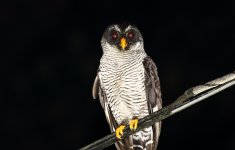5/30/21
Today would be another day, heading out of the Tower around 6:00 am. Today I would be spending the entire day with Jorge, which I was more than happy to do. The major goal this morning was to bird around the Rainforest Discovery Center. This private preserve is located in the pipeline area and has its own tree-top tower, as well as hummingbird feeders, a small system of trails, and a large pond. I think looking back this was by far one of my favorite mornings while staying at the Canopy Tower and I think one of the best locations overall. Definitely a strong recommend, especially for those folks who want the canopy experience without staying at the Tower.
First off though, we made a stop at Ammo Ponds to retry for kingfishers (which had a poor showing so far on this trip) and the crake, who Jorge says is usually more active in the morning. While looking for kingfishers (with no luck), we observed some rustling near one of the fences. which soon turned out to be Tamandua #4! Jorge said he had never seen a guest log so many Tamanduas in one trip, although this one certainly gave the worst views. We also ran into another group of birders, a local private guide (Canadian born) with her own company, Whitehawk tours, who was guiding two elderly Americans. They had a couple of White-throated Crakes that were cooperative, and we soon were able to get views at this species we dipped on earlier
After that, it was off to Rainforest Discovery Center. We made a beeline to the observation tower, birding the trails along the way. This was productive, giving me several more skulky forest floor birds, in this case a cooperative Black-faced Antthrush, Orange-billed Sparrows and a Scaly-throated Leaftosser. This was another high priority target, as leaftossers are with miners sometimes put in there own family. Other new birds seen on the way to the observation tower included White-flanked Antwren and Spot-crowned Antvireo.
Then was the long laborious climb up Cirith Ungol...I mean the observation deck. While heading up we came across several roosting Lesser White-lined Bats. Overall, I found the observation deck here to be a different birding experience than the one at the tower. The tower felt like it was a bit better for small songbirds, with more trees surrounding the towers. In contrast, being closer to Pipeline Road made this a bit better for larger birds. Oddly enough despite missing any kingfishers at ammo dump pond, we had a flyby Green Kingfisher here. Beyond many of the birds that also frequented the Tower, we added Short-billed Pigeon, Pied Puffbird, Linneated Woodpecker, White-necked Jacobin, and a Gray-headed Kite. We also had a pair of Blue Cotingas, this time including a beautiful male bird.
Coming down to the Tower we next headed to the fairly large pond (really a lake). On the way along the trails we encountered a nice cluster of activity, which included Slate-colored Grosbeaks and Dusky Antbird. Most exciting was a Speckled Mourner, an uncommon bird for the tower area. Upon reaching the Pond, we spent some time scanning the pond and pond edges. Howler Monkey called from around the pond, and an impressive American Crocodile lurked in the lake. Having just seen Speckled Mourner, a Rufous Mourner decided to show up for comparative purposes.
We then headed out towards the entrance, first visiting the hummingbird feeder area. This was popular with both tourists and locals, who are able to get up close to to some attractive hummers. Interestingly, the hummers here were almost entirely different from those at the Tower, With White-necked Jacobin, Crowned Woodnymph, and Blue-chested Hummingbird the dominant species. Jorge also took me to look UNDER the building. Beyond the ubiquitous white-lined bats, a colony of Sheba's Short-tailed Bat was also present, increasing my bat list.
We continued down the trail, along the way encountered White-tailed Trogon (the last of the trogons I needed locally) and the recently split Trilling Gnatwren. This used to be Long-billed: SACC split it and renamed it Trilling (vs Chattering), and IOC followed suite. NACC also just split it, but for some reason kept it Long-billed. Because we need more confusion in bird names apparently. New on the mammal front was Panamanian White-faced Capuchin, split from the Capuchins in the Darien, although to be perfectly honest I think the primate splitting might be going a bit too far and I could see them getting lumped back together. This was the final realistically possible (Barro Colorado has Spider Monkeys, but no access due to COVID) primate I needed from the Tower area, and surprisingly uncommon. I think its fully possible to do a week at the Tower and not see any.
On the entrance road we scored big: a very large army antswarm was moving along and across the road! We had seen a few tiny swarms, but this was the real deal. Present here were numerous birds, most I had seen earlier, including Gray-headed Tanager, Northern Barred and Plain Brown Woodcreepers, Song Wren, Checker-throated Stipplethroat, and Bicolored and Spotted Antbird, most right next to the road at hip level or even lower, and sometimes in the road itself. No ground-cuckoos, but another trip-highlight was present: several Ocellated Antbirds! A really cool and uncommon species, and an obligate antswarm follower. Not following the ants but also new was a high overhead flying White Hawk.
Now it was time to head back, but the morning would have one more awesome surprise in store. As we arrived at the entrance of the Canopy Tower, Jorge soon excitedly dashed out of the vehicle with it barely stopped, and quickly got me on a beautiful and close perched Black Hawk-Eagle right over the road. It didn't stick around long, but still truly awesome views in the brief time I was able to observe it.








